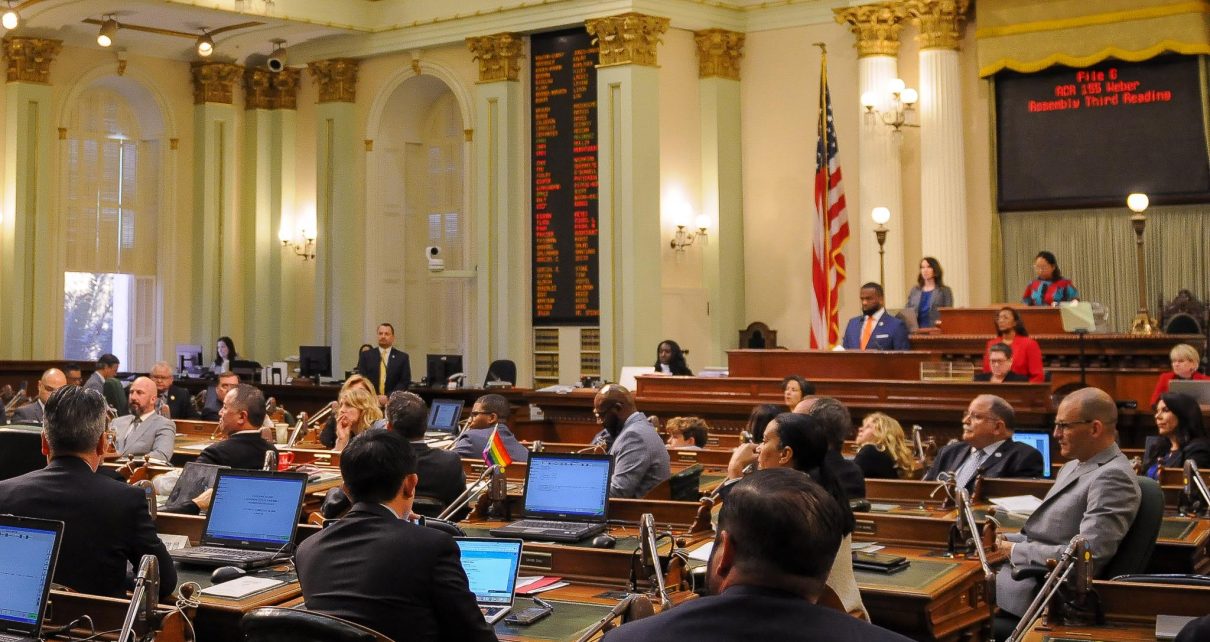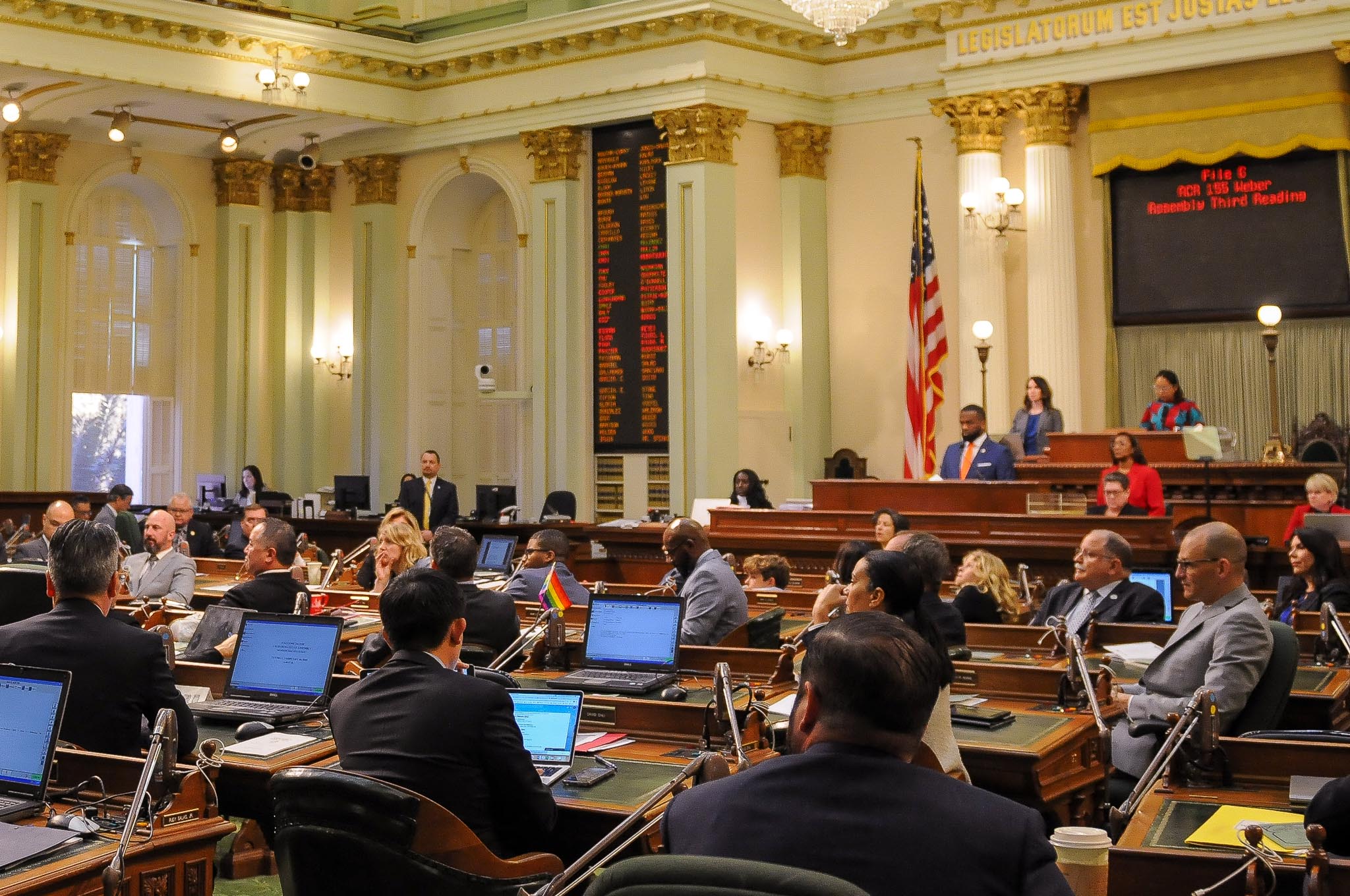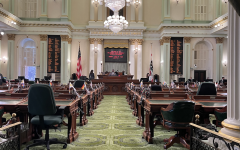
California State Assembly. (Photo: Kevin Sanders for California Globe)
Frequently Asked Questions about ‘Plus Sections’ in California Bills
What is an example of a double-jointing amendment?
By Chris Micheli, December 12, 2023 6:49 am
What is a double-jointing plus section? This section is used to address when one bill would “chapter out” the language of a bill that amends the same code section if it got enacted earlier.
What is an example of a double-jointing amendment? “Section 2.5 of this bill incorporates amendments to Section 11106 of the Penal Code proposed by both this bill and Senate Bill 715. That section of this bill shall only become operative if (1) both bills are enacted and become effective on or before January 1, 2022, but this bill becomes operative first, (2) each bill amends Section 11106 of the Penal Code, and (3) this bill is enacted after Senate Bill 715, in which case Section 11106 of the Penal Code, as amended by Section 2 of this bill, shall remain operative only until the operative date of Senate Bill 715, at which time Section 2.5 of this bill shall become operative.”
What is a contingent enactment plus section? This section is used to make the bill contingent upon the enactment of another bill or event.
What is an example of a contingent enactment amendment? “Sections 16 and 17 of this act shall become operative only if Assembly Bill 136 of the 2021–2022 Regular Session is enacted and becomes effective.”
What is a severability plus section? This section is used to protect other provisions of a bill if another provision is found to be invalid or voided by a court.
What is an example of a severability clause? “The provisions of this act are severable. If any provision of this act or its application is held invalid, that invalidity shall not affect other provisions or applications that can be given effect without the invalid provision or application.”
What is a “no appropriation” plus section? This section is used when there is not an appropriation that would otherwise have to be made pursuant to the Welfare and Institutions Code.
What is an example of a “no appropriation” clause? “No appropriation pursuant to Section ___ of the Welfare and Institutions Code shall be made for purposes of implementing this act.”
What is a Section 2230 Waiver plus section? This section is used when a bill exempts property from the sales/use tax and the Legislature does not want to reimburse local governments for the lost sales/use tax.
What is an example of a Section 2230 Waiver clause? “Notwithstanding Section 2230 of the Revenue and Taxation Code, no appropriation is made by this act for purposes of Section 2230 of the Revenue and Taxation Code and the state shall not reimburse any local agency for any sales and use tax revenues lost by it as a result of the amendments to Sections 6369.9 and 6369.10 of the Revenue and Taxation Code made by this act as required by Section 2230 of the Revenue and Taxation Code.”
What is a Section 41 Finding plus section? This section is used to comply with Revenue and Taxation Code Section 41, which is used to make legislative findings and declarations, and specify performance metrics to be used to evaluate the tax expenditure’s effectiveness.
What is an example of a Section 41 Finding clause? “For purposes of complying with Section 41 of the Revenue and Taxation Code, the purpose of the small business hiring credits allowed by Sections 6902.9, 17053.71, and 23628 of the Revenue and Taxation Code, as added by this act (hereafter “the credits” for purposes of this section), is to provide financial relief for the economic disruptions resulting from COVID-19 that have resulted in unprecedented job losses.”
What is a gift of public funds disclaimer plus section? This section is used to specify that a retroactive payment or other law change does not constitute a gift of public funds.
What is an example of a gift of public funds disclaimer clause? “The COVID-19 emergency has had a significant and disproportionate negative impact on the financial health of many low- and middle-income Californians. Furthermore, the COVID-19 emergency has caused many low- and middle-income families to face the loss of jobs, loss of income, increased costs, and increased risks to their personal health and safety. The Legislature hereby finds and declares that the payments authorized by Section 8150.2 of the Welfare and Institutions Code serve the public purpose of providing financial relief for low- and middle-income Californians who may have been adversely impacted by the economic disruptions resulting from the COVID-19 emergency, and do not constitute gifts of public funds within the meaning of Section 6 of Article XVI of the California Constitution.”
What is a reimbursable mandate plus section? This section is used when it is necessary to disclaim any reimbursement to local agencies when a bill would create a new crime.
What is an example of a reimbursable mandate clause? “No reimbursement is required by this act pursuant to Section 6 of Article XIII B of the California Constitution because the only costs that may be incurred by a local agency or school district will be incurred because this act creates a new crime or infraction, eliminates a crime or infraction, or changes the penalty for a crime or infraction, within the meaning of Section 17556 of the Government Code, or changes the definition of a crime within the meaning of Section 6 of Article XIII B of the California Constitution.”
What is a 2011 realignment legislation plus section? This section is used when local agencies are required to implement new programs or expanded levels of service beyond those imposed as part of the 2011 Realignment legislation.
What is an example of a 2011 realignment legislation clause? “To the extent that this act has an overall effect of increasing certain costs already borne by a local agency for programs or levels of service mandated by the 2011 Realignment Legislation within the meaning of Section 36 of Article XIII of the California Constitution, it shall apply to local agencies only to the extent that the state provides annual funding for the cost increase. Any new program or higher level of service provided by a local agency pursuant to this act above the level for which funding has been provided shall not require a subvention of funds by the state or otherwise be subject to Section 6 of Article XIII B of the California Constitution.”
What is a furthering the purposes of an initiative plus section? This section is used when a bill amends a statutory initiative adopted by the voters whose amendment is permitted by the adopted ballot measure.
What is an example of a furthering the purposes of an initiative clause? “The Legislature finds and declares that this act furthers the purposes and intent of the Control, Regulate and Tax Adult Use of Marijuana Act.”
What is a public right of access disclaimer plus section? This section is used when a bill limits the public’s right of access to local or state government meetings or public writings.
What is an example of a public right of access disclaimer clause? “The Legislature finds and declares that Section 2 of this act, which adds Section 502 of the Business and Professions Code, and Section 17 of this act, which adds Section 103871.1 of the Health and Safety Code, imposes a limitation on the public’s right of access to the meetings of public bodies or the writings of public officials and agencies within the meaning of Section 3 of Article I of the California Constitution. Pursuant to that constitutional provision, the Legislature makes the following findings to demonstrate the interest protected by this limitation and the need for protecting that interest:”
What is a special statute plus section? This section is used when a general statute will not suffice and a special statute is required instead.
What is an example of a special statute clause? “The Legislature finds and declares that, with respect to the amendments to Section 54234 of the Government Code made by Section 3 of this act, a special statute is necessary and that a general statute cannot be made applicable within the meaning of Section 16 of Article IV of the California Constitution because of the unique circumstances relating to the Metro North Hollywood Light Joint Development Project in the County of Los Angeles.”
What is an urgency clause plus section? This section is used when an urgency clause statute is required.
What is an example of an urgency clause? “This act is an urgency statute necessary for the immediate preservation of the public peace, health, or safety within the meaning of Article IV of the California Constitution and shall go into immediate effect. The facts constituting the necessity are:”
What is a bill related to the Budget Bill plus section? This section is used for any budget trailer bills, which are used to make statutory changes to implement the budget.
What is an example of a Bill related to the Budget Bill clause? “This act is a bill providing for appropriations related to the Budget Bill within the meaning of subdivision (e) of Section 12 of Article IV of the California Constitution, has been identified as related to the budget in the Budget Bill, and shall take effect immediately.”
- Commencing Civil Actions in California - July 29, 2025
- Minors Enlisting in the Armed Forces - July 28, 2025
- Remote Marriage Licenses in California - July 27, 2025







